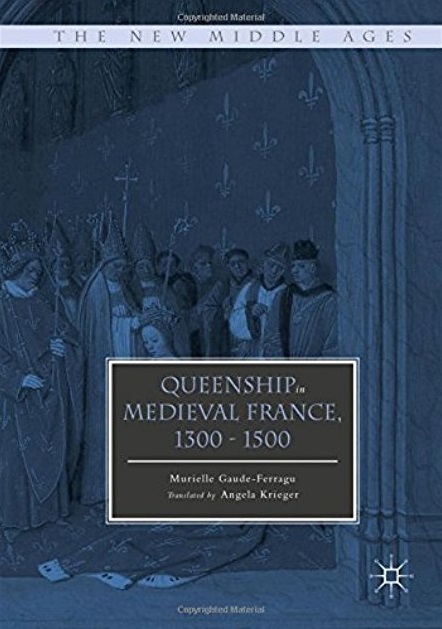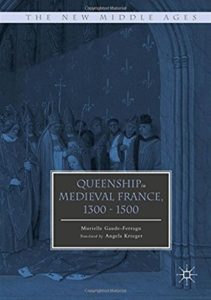
Queenship in Medieval France, 1300-1500 by Murielle Gaude-Ferragu, translated from the French by Angela Krieger

A recent reviewer in this journal posited that medieval queens represented a tiny minority of women – to which I would add that medieval kings likewise represented a tiny minority of men. However, while the stories of medieval kings, and indeed their kingships, have received considerable scholarly attention for decades, if not for a hundred years or more, studies of medieval queens, and queenship in general, as legitimate fields of cross-disciplinary research really only received their “shot in the arm” following John Carmi Parson’s ground-breaking and durable collection of essays, Medieval Queenship, first published in 1993. His collection of essays aimed to avoid the biographical sketches of individual queens in the “great white women of history” tradition of historiography seeking instead “to dissect the ways in which queens pursued and exploited means to power, and how their actions were interpreted by history.” (Parsons 1993, 2). To some extent, and some twenty years on, Murielle Gaude-Ferragu’s book builds upon Parsons’s earlier thinking.
The Editors of The New Middle Ages Series, published by Palgrave Macmillan, commissioned the translation of Gaude-Ferragu’s 2014 monograph in French, La Reine au moyen âge: le pouvoir au féminin xive-xve siècle, France, (Tallandier) rebranding it in English in 2016 as Queenship in Medieval France 1300-1500. It will find a home in many scholarly book stacks – particularly those of entry level Anglophone scholars in the field interested in, but largely unacquainted with, medieval French queenship. The English edition of Gaude-Ferragu’s work is more workmanlike than its French original. For example, it does not include the seven pages of full color plates (fourteen artefacts in all), and the detailed descriptions of each to be found in the French version. The English edition does, however, include five “figures” or plates, reproduced in black and white, with the digitized images widely available online “at the source” for those who wish to visualize them in their full beauty and vibrancy.
Like William Monter’s 2012 monograph, The Rise of Female Kings, Gaude-Ferragu’s book lacks a clear and recognizable analytical framework, and at times it reads as a catalogue rather than an analytical study of the queens whose memories she seeks to revive. Indeed, Gaude-Ferragu’s book shares many points of similarity with Monter’s offering, with one reviewer of the latter nailing its deficiencies in observing that Monter “constructs a sort of roughly chronological quantitative interpretation—perhaps not the best approach to a historical problem that is by nature qualitative.” (Beem 2013) This observation regarding Monter’s work expresses succinctly some of the reservations I hold regarding Gaude-Ferragu’s work here under review.
Gaude-Ferragu provides her reader with a list of fourteenth-fifteenth century queens-consort, dividing her gallery of players into two sections “The Last Direct Capetians” and the junior branch, “The House of Valois” or indirect Capetians, who succeeded them in the absence of male heirs at the end of the so-called “Capetian Miracle.” In keeping with the original French language edition, the English version of the Gaude-Ferragu’s work is divided into three broad sections: “Acceding to Royal Dignity;” “A Woman in Politics: The Power of the Queen;” and “The Symbolic Government.” In turn, each section contains three chapters, which explore and unpick various questions raised by Gaude-Ferragu as she lays out her catalogue of late medieval French queenship.
The Introduction commences not with the naming of a late medieval French queen, but rather by zeroing in on a celebrated royal female favourite, Agnès Sorel – the first to occupy the post of official royal mistress. Gaude-Ferragu raises the possibility of deliberate mercury poisoning of la belle Agnès – a politically galvanized and effective operator at the court of Charles VII. While Agnès’s leavings were exhumed and tested by a scientist in 2004, leading the discovery of a considerable amount of mercury in her system, which might or might not have led to her speedy and unexpected demise, we should be cautious as to whether we conclude that she was deliberately poisoned for attempting to foil a plot against her king-lover. The scientist concerned certainly has not made this claim, and I personally do not hold with a recent thesis that the king’s mistress was some sort of ‘political martyr’ to Charles VII’s cause and survival. In truth, it is known that Agnès suffered throughout her life from severe intestinal parasites (worms) and, at the time, the go-to remedy for the treatment of her chronic condition involved significant doses of mercury. Added to this, medieval cosmetics, particularly those designed to brighten and clarify the female complexion (Agnès, dame de la Beauté, was renowned for her flawless visage and pale skin), contained extraordinary quantities of toxic ingredients, including mercury, lead, and arsenic.
Gaude-Ferragu employs her opening aside to highlight that Charles VII’s mistress is better remembered than his queen and to set up the king’s mistress in opposition to Charles VII’s legitimate consort, Marie of Anjou, whom she assumes to be, and names, Agnès’s “bothersome rival.” Gaude-Ferragu’s point here seems to be that many of the French queens-consort of this period have been relegated to the shadows of history – that only the names of Isabeau of Bavaria and Anne of Brittany appear to have survived in the greater public’s imagination. She posits that, to some extent, the oblivion into which queens such as Clementia of Hungary, Joan of Burgundy, Joan of Évreux, Joan of Bourbon, and Charlotte of Savoy have been cast has been exacerbated by the fact that no courtly portrait has placed them at the forefront of historical events – but nor were kings, at least up until the reign of Charles VII. (2) While it is true that that the wives of fifteenth century kings were rarely represented in easel portraiture during the fifteenth-century, we should not assume that that they lived their lives in the shadows and that they were not active agents in the unfolding of major political events.
In her introductory discussion, and elsewhere in her book, regarding how queens-consort of later medieval France had been excluded from the line of succession from 1316, Gaude-Ferragu appears to be wedded to a rather old-fashioned view combined with an insufficiently nuanced understanding of the ways in which these queens actually functioned – and in many cases, subverted the rules of the gendered game of rulership. She has not engaged with the work and ideas of more recent medieval and early modern queenship scholars such as Theresa Earenfight, Claire Ponsich, and Núria Silleras-Fernandez who, while largely scholars of Iberian queenship practice, have made important points that are applicable and relevant to the study of late medieval French queenship norms. She likewise seems not to consider either Michel Foucault’s ideas regarding the exercise of power (which exists only in its action) and authority (which is “officially” sanctioned – but sometimes unable to be exercised), nor indeed the thoughts of Natalie Zemon Davis as to how sex roles might shape a political career. And, while Gaude-Ferragu makes considerable use throughout her book of Fanny Cosandey’s La Reine de France. Symbole et pouvoir, she does not engage with Cosandey’s more focused discussion in “De lance en quenouille. La Place de la reine dans l’État modern (XIVe-XVIIe siècles)” regarding the evolution of the ‘official’ position and potential power of French queens following on from Charles VI’s ordinance of 1407 and the preceding legislative work undertaken by his father, Charles V. In the same vein, had the author chosen specifically to consult Craig Taylor’s “The Salic Law, French queenship, and the Defense of Women in the Late Middle Ages,” a more nuanced understanding of the implications for queens of the furious Valois legislative activity undertaken from 1316 to ensure that the French crown remained in French hands might have emerged from the pages of her book.
To some extent, however, Gaude-Ferragu manages to salvage matters towards the end of her Introduction, and in her later discussion, but even in these cases she adheres to the two sphere – or public versus private – model of political undertaking. She does not seem to have sufficiently taken into account that there has been a marked shift in premodern political historiography and scholarship away from the study of the formal or professional sphere of institutions and office bearers towards informal political spheres, such as the non-institutional and the domestic. Recent work in the field has demonstrated that all modern political systems have been produced within an informal political arena alongside government. For example, scholars have identified how women served as conduits and bonds to bind together male office-bearers and rulers of late medieval and early modern polities. (Vivo 2007 Chojnacki 2000) My own research has demonstrated that queens-consorts were no mere horizontal conduits of support and influence for the benefit of their spouses and male relatives – they were political actors in their own right. Many such examples abound, both in late medieval France as elsewhere, and this point is not sufficiently driven home in Gaude-Ferragu’s book. Institutional leadership by women might not have been possible in late medieval France, but its queens had a role to play and were instrumental to the success of its reigning dynasties. For the most part, its queens were key political players integral to the centralization and bureaucratization of the institution of monarchy. The twelfth-century centralization of monarchical power and authority benefited not only male monarchs but also their consorts: it cemented the queen as a constitutive component of the emergent state. Gaude-Ferragu might have more effectively considered that the domestic strongholds of the late medieval queens she examines were potential, or indeed actual, political powerhouses that deserve to be examined and read more thoroughly through the lenses of gender and influence. In this way, the author might have more convincingly accomplished her stated challenge of “grasping the meaning and complexity of the office of queen”, and thereby “elaborating a female history of power.” (8)
In part 1 chapter 1, the author examines the idea and implications of “Marrying the King”, and the ways in which matrimonial strategies should be conceived of as diplomacy in action, a soft form that reinforced alliances and underpinned peace and reconciliation, serving as placatory unions and instruments of territorial expansion. The selection of a suitable wife for a king also reinforced a dynasty by bringing together prestigious blood ties, which served to buttress the survival of the monarchy. Gaude-Ferragu makes the important point, frequently overlooked, that it was not just a question of selecting a princess from an impeccable bloodline; the more crucial consideration was that the princess be educated and well-prepared for the important role she would be required to fill. However, Gaude-Ferragu fails to acknowledge that this was not always the case. Isabeau of Bavaria proved to be dangerously underprepared for the essential role into which she was drafted. Dynastic marriages were also financial transactions, and considerable negotiation was required to draft marriage contracts agreeable to both parties. They were also Christian rituals, ones which involved splendour in the form of the exchange of precious gifts – this too was transactional. Moving on from these aspects, Gaude-Ferragu takes time to consider conjugal affection and the frequent separation of the royal couple. There are several instances of rather ropey and misleading translations sprinkled throughout this section and in other parts of the work, but space does not allow me to detail them here. Some might think this is pernickety criticism on the part of this reviewer, but such instances altered the emphasis of several of Gaude-Ferragu’s observations leading to a degree of misunderstanding until the original French version was consulted.
From the topic of affectio maritalis the author moves on to the subject of the royal mistress – again, predictably, to Agnès Sorel. Gaude-Ferragu relates how she eclipsed Charles VII’s queen, Marie of Anjou, from whose court she had emerged. The author, like many others before her, assumes that Marie was some sort of a royal doormat, who had readily surrendered her place at Charles VII’s court to her dazzlingly beautiful ex-lady-in-waiting. Those who have delved into the personality and deeds of Charles VII le Bien Servi (the Well Served) have discovered his penchant for rather odious, self-serving, and very unhelpful, male favourites from the earliest days of his reign. His mother-in-law, Yolande of Aragon, with the able assistance of Charles’s Constable, Arthur III de Richmont, were obliged from about 1424 to 1433 to pick these parasitic individuals off one by one – some of whom were incredibly difficult to dislodge. While Yolande might not have thrown Agnès into Charles’s path as Michelet claimed, there are grounds to believe that Queen Marie might have voluntarily tolerated Agnès’s presence for “the good of the firm.”
Insufficient attention has been paid to Charles VII’s self-effacing queen, Marie of Anjou, but she was a woman of political substance, one who does not deserve to be dismissed so casually by Gaude-Ferragu who relies too heavily upon the very limited research into the life and deeds of Marie of Anjou undertaken by Bernard Chevalier (one article on the subject of Marie of Anjou, “Une Reine sans gloire,” published almost twenty years ago). Gaude-Ferragu’s uninterrogated acceptance of second-hand, non-specialist and, at times, rather stale research, detracts from her aims for the book: the revival of the memory of the forgotten queens of late medieval France. She would have been better served to have visited the archives on her doorstep where she would have discovered that far from being a “queen without glory,” Marie of Anjou acted as Charles VII’s lieutenant on more than one occasion, and was frequently called upon to assist her mother Yolande in her strategic undertakings to buttress Charles’s sovereignty and his successful claim to the throne of France, removed from him in 1420 in favour of Henry V of England by his birth-mother Isabeau of Bavaria and his “absent” father, Charles VI. This was precisely the scenario that the re-galvanized Salic Law had been designed to avoid.
Part I chapter 2 tackles ‘Marrying the Monarchy’ and drills down into the important issue of the queen’s coronation. Gaude-Ferragu walks the reader the very significant innovations made by Charles V for his consort’s coronation ritual. She discusses the intricate symbolism woven into his new ritual. Joan of Bourbon was the last queen to be crowned in Reims with her husband-king, Charles V. Her successor, Isabeau of Bavaria’s official entry into the city of Paris, and her coronation, five years after her marriage, is given attention, but its motivations are not perhaps analysed with a sufficiently critical eye. Marie of Anjou did not receive a coronation, but Gaude-Ferragu omits to elaborate upon the fact that she was packed up and ready to join Charles VII in Reims but was turned back at the last minute (with her powerful mother, Yolande of Aragon) by the order of Charles’s self-seeking favourite, Georges de la Trémoïlle, who feared, in the words of one contemporary chronicler, that the queen, her mother, and their allies would “assume control of the king, or otherwise displease him”. With odious and obstructionist favourites like Trémoïlle and his rusted-on predecessor, Jean Louvet, it is little wonder that Marie of Anjou tolerated, and possibly even encouraged, Charles’s female favourite, the more easily malleable Agnès Sorel – issue of her own household and a dedicated patron of Angevin crown officers such as Pierre de Brézé. Marie’s daughter-in-law, Queen Charlotte of Savoy, likewise did not receive a coronation, with Gaude-Ferragu observing quite correctly that, during the fifteenth-century (and given the upheaval caused by the Treaty of Troyes in 1420), the king’s legitimacy depended upon his birth and not in any way upon a coronation, which had “no legal value whatsoever.” (51)
Part 1 chapter 3 deals with the queen’s most important duty to the crown and her marital kingdom – “Bearing the Blood of France.” Gaude-Ferragu argues cogently the indispensability of motherhood and the queen’s duty to produce heirs (and spares) for France. This “job” was full of hazards for the queen, particularly during pregnancy and childbirth. The “Mother as Educator” is an important theme raised by Gaude-Ferragu in this chapter, and she concludes the chapter by stating that queenship was very much a “profession” to be learned and practiced in the public sphere, which leads neatly to part 2 of the book, “A Woman in Politics: The Power of the Queen.”
Part 2 chapter 4, ‘The ‘Profession’ of the Queen’ aims to respond to the question: What was the queen’s place in the monarchical system of France? Gaude-Ferragu commences by laying out her thesis that female royal power in France pretty much evaporated in a post-lex salica world. Any recent study of the actual situation renders such a proposition false, and anachronistic (see my earlier comments). It is simply not the case that “The queen’s authority began to wane under the reign of Philip Augustus (d.1223), jointly influenced by the progressive consolidation and centralization of royal power along with the development of clerical misogyny (…)” (80) This was the view put forward by Facinger in 1968, and it has largely been debunked in the intervening decades. Likewise, Gaude-Feragu’s accompanying statement, “Female royal power seems to have lost all influence when the daughters of France were excluded from the crown in the fourteenth century” (80), holds very little water when set against the wealth of research now readily available to queenship scholars. Gaude-Ferragu’s lack of engagement with the sources, and relevant research, erodes the very good points that she eventually makes in this section of her work, but where she appears sometimes to argue against her earlier statements.
Chapter 5 is likewise peppered with inconsistencies and courageous generalizations. For example, “Female regency was far from common during the Middle Ages” (111). I (and others) would argue here, as elsewhere, that female regency and lieutenancy was largely unexceptional during the Middle Ages – in France and beyond. Gaude-Ferragu’s statement that “during the fourteenth and fifteenth centuries, two queens actually played the role of ‘kings lieutenant’ (…) is misleading, perhaps causing a non-specialist reader to believe that this only included the two queens of whom the author makes mention. Curiously, Gaude-Ferragu does not mention Marie of Anjou’s lieutenancy in her specific discussion of the “rarity” of queens-lieutenant in the late Middle Ages, but she does recall Marie’s exercise of this function for Charles VII in her section, “Queen and Auctoritas.” (89) Chapter 6 provides the reader with a sound discussion of the ceremonial obligations of queens-consort as well as an exposition of the queen’s ‘allegorical body, and her ‘final triumph: her death and funeral.
The strongest section of the book is part 3: ‘Symbolic Government’ wherein Gaude-Ferragu reveals the intricacies of the queen’s household and nominally ‘private’ life. Her discussion here is very good; it is simple (though not simplistic), concise and informative. However, Gaude-Ferragu errs with her claim that “Marie of Anjou’s hôtel was also the setting in which an official astrologist first made an appearance, according to the account books.” (159) This is not the case, but space forbids me from detailing a list of court astrologers included in household accounts of both kings and queens prior to 1450. The most notable example would be Tommaso di Benvenuto da Pizzano, father of Christine de Pizan, summoned by Charles V to occupy the post of court physician-astrologer from 1368. Moreover, Marie’s own mother, Yolande of Aragon, queen of Sicily and Jerusalem, likewise included an official astrologer in her household. This was by no means unusual for the time. Chapter 8 has Gaude-Ferragu on her firmest footing, book-ending her earlier work in French, D’Or et cendres (2005). Chapter 9 deals lucidly with issues such as, “Art and Politics;” “Books and Culture;” and the important subject of “Queens as Cultural Advocates and Patronesses.” The short Conclusion, regarding “the power and role of the last medieval queens, who in France were never simply the “wives of kings” rounds out her study.
Although there are significant points of strength, and much valuable information to be had in Gaude-Ferragu’s book, it suffers to some extent from silo-thinking. The author might have considered an approach to late medieval French queens-consort that took into account the situations and agency of their “sisters” – queens-consort operating in contemporaneous polities with whom many shared familial ties. The absence of engagement with the research of notable queenship scholars, some of whom I have mentioned above, renders the work a little old-fashioned in its method and thinking. The failure to mention Theresa Earenfight’s Queenship in Medieval Europe (Palgrave Macmillan, 2013), or her “Without the Persona of the Prince: Kings, Queens, and the Idea of Monarchy in Late Medieval Europe,” (Gender and History, April 2007) is a significant oversight. Had Gaude-Ferragu engaged with specialized queenship scholarship to a greater extent, her book would have been less patchy and more relevant to today’s queenship scholars whose research demands a more determined sans frontières approach.
Reviewed by Zita Eva Rohr, Macquarie University
Queenship in Medieval France, 1300-1500
Murielle Gaude-Ferragu, trans. Angela Krieger
Publisher: Palgrave Macmillan
Hardcover / 224 pages / 2016
ISBN: 978-1-137-60273-2
To read more book reviews, please click here.
Published on April 17, 2018.




